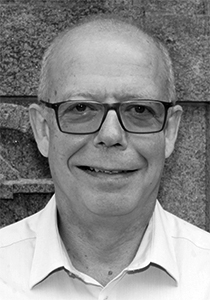Citation

Dr. Michael Hesse is recognized for his outstanding achievements in space plasma physics and his scientific leadership of the rapidly developing field of space weather modeling. His pioneering science includes seminal work on magnetic reconnection, the basic mechanism by which magnetic fields and matter exchange energy in our space environment. Understanding magnetic reconnection is a primary objective of both NASA’s Living With a Star and the National Science Foundation’s space weather modeling programs and is the main science driver for the European Space Agency’s Cluster mission and NASA’s Magnetospheric Multiscale Mission (MMS). His research explained, for the first time, the critical role of parallel electric fields in three-dimensional reconnection. His theory of magnetic topology in reconnection predicted the complex structure of magnetospheric flux transfer events that was later confirmed by numerical simulations and by observations from the International Sun–Earth Explorer (ISEE) and Cluster missions. Dr. Hesse developed the first comprehensive theoretical explanation, verified by numerical simulation, for the magnetotail current sheet thinning, midnight current wedge formation, and plasmoid acceleration that underlie current modeling of magnetic storms in the Earth’s magnetosphere.
Hesse’s recent work demonstrates that the dissipative effects of nongyrotropic electron dynamics control the structure and evolution of the central reconnection layer in space plasmas. The mechanism that is responsible for breaking the magnetic flux during collisionless reconnection has been an issue of intense debate by space plasma physicists worldwide for decades. The flux-breaking mechanism is critical for developing any robust space weather model. His theory has been verified by the unprecedented electron-scale measurements from the MMS mission at both the magnetopause and the magnetotail. The structure of the nongyrotropic electron distribution functions predicted by Dr. Hesse has been the key guidance for identifying the core reconnection layer in MMS measurements. His theory and simulation work establishes a fundamentally important basis for space weather modeling.
In addition to his impactful scientific research, Dr. Hesse has made visionary contributions to the advocacy and organizational development of space weather science. He conceived of, founded in 2000, and successfully led the Community Coordinated Modeling Center (CCMC), with the mission to be “a multi-agency partnership to enable, support, and perform the research and development for next-generation space science and space weather models.” The CCMC was a revolutionary step in space weather science and remains a critical service to the broad heliophysics community.
—Holly Gilbert, NASA Goddard Space Flight Center, Greenbelt, Md.
Response
It is a great honor for me to receive the 2019 AGU Space Weather and Nonlinear Waves and Processes Prize. Even though this prize is awarded to me, my work was shaped by and benefited hugely from the excellent people I had the pleasure of learning from and working with throughout my research career. Therefore, this award should really be seen as a recognition of all of them—from those who pointed me in the right direction in the beginning, to the young ones who keep me light on my feet and honest today.
Looking at the former category, my research career couldn’t have started without my mentors: Karl Schindler, who as my Ph.D. adviser taught me the proper way to understand space physics; Joachim Birn, who kept me on the path of virtue; and Dan Winske, who awakened my interest in kinetic processes.
After moving to the NASA Goddard Space Flight Center (GSFC), Jim Slavin and Rob Pfaff taught me to look at data with interest instead of fainting, and my career-long partnership with Masha Kuznetsova started. Discussions with Masha often started with “novyye veyaniya” (new trends), which means that everything we believed yesterday was incorrect. What a way to be forced to think creatively! Together we started the CCMC, and together with colleagues like Lutz Rastaetter, Marlo Maddox, and Anti Pulkkinen followed our vision to provide a community service to the world. All of this would have been impossible without my dear friend Tamas Gombosi, who was brave enough to entrust his model to us. I owe all of them huge thanks for all we accomplished during a large number of years.
Regarding reconnection research, I need to thank specifically my postdoctoral fellows at GSFC, Seiji Zenitani, Nico Aunai, and Yi-Hsin Liu. It was a true blessing for me to be able to work with you. At GSFC, I was also joined by Li-Jen Chen and Naoki Bessho and, remotely, by Shan Wang. Li-Jen and Shan removed all my scruples when it comes to MMS data analysis, and Naoki could uncover any holes in my theories and models. It is wonderful to be able to work with you to this day. My gratitude also goes to Jim Burch, who made MMS happen, and, despite my occasionally cantankerous attitude, never gave up on working with me. Indulging in scientific research while division director at GSFC would have been impossible without the best leadership team anybody could hope for. My thanks here go specifically to Holly Gilbert, Marlo Maddox, and Mike Horn.
Since moving to Norway, I have enjoyed the youthful creativity and ingenuity of Paul Tenfjord, Cecilia Norgren, Norah Kwagala, Susanne Spinnangr, and Håkon Kolstø. Our daily meeting is the undisputed highlight of my day, and you continue to amaze me with your skills and attitude.
Finally, I wouldn’t be who I am without my family, beginning with Therese, the love of my life, who always has time to listen to crazy ideas and ruminations despite having an extremely challenging job herself; and our children, Benjamin, Sebastian, and Sabrina, who forced withdrawal from workaholism on me. You were with me during ups and downs of life. I can never thank you enough.
—Michael Hesse, University of Bergen, Bergen, Norway
Citation:
(2020), Hesse receives 2019 Space Weather and Nonlinear Waves and Processes Prize, Eos, 101, https://doi.org/10.1029/2020EO149326. Published on 17 September 2020.
Text © 2020. AGU. CC BY-NC-ND 3.0
Except where otherwise noted, images are subject to copyright. Any reuse without express permission from the copyright owner is prohibited.
